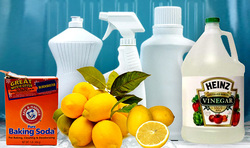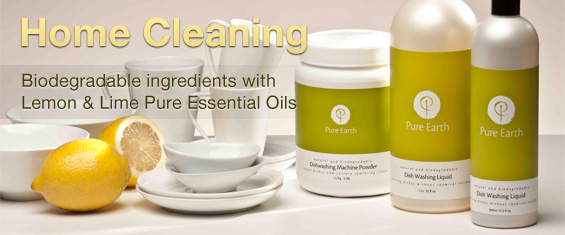Toxic Detergents
How we do our laundry, clean our homes and bathe ourselves has changed more in the last 70 years than it has in the previous 7,000 years. None of these changes have been kind to your skin, or good for your health.The name brand chemical based laundry detergents, household cleaners, soaps, and shampoos that you use in your day to day life contain carcinogens, neurotoxins and envirotoxins.
Everyday, all day long, you are surrounded by and in close contact with chemicals that are known to cause acne, allergies, cancer (melanomas), eczema, psoriasis, premature aging of your skin, rashes, and neurodegenerative disorders in children.
Twelve highly toxic chemicals to banish from your home
- DEET (N, N-Diethyl-meta-toluamide) is the most common active ingredient in insect repellents. One-third of all Americans use this repellant, which has been shown to be toxic to the central nervous system. Natural insect repellant solutions exist; otherwise, candles with eucalyptus oil or citronella oil in the area will do the trick.
- Glyphosate is the chief ingredient used in Monsanto's Roundup, which has been link to birth defects, DNA damage, hormone disruption, cancer and neurological disorders. Ditch this weed killer for good. Get rid of weeds naturally, using boiling water, vinegar, salts or pulling them out by hand.
- Phthalates are most commonly found in air fresheners. They also exist in vinyl, wood varnishes and lacquers. Pthalates disrupt the endocrine system, which can cause reproductive and neurological damage. Avoid the word "fragrance" on air fresheners, as it can be a synonym for pthalates. Candles are a better alternative.
- Bisphenol A (BPA), which is found in nine out of ten Americans, is used in food containers, baby bottles, plastic bottles and CDs. Scientists have linked BPA to heart disease, diabetes and liver abnormalities, as well as brain and hormone development problems in fetuses and children. Be sure to buy BPA free plastics with recycling codes 1, 2 or 5. Recycling codes 3 and 7 are more likely to include BPA or phthalates.
- Volatile organic compounds (VOCs) are emitted as gasses from certain solids or liquids. These unsafe substances add to indoor air pollution and are linked to asthma and cancer. Paints, pesticides, lacquers, building materials and office equipment can all contain VOCs; however, the biggest culprit of VOC emissions in the home are scented, petroleum-based laundry detergents. Instead, buy plant based, unscented laundry detergents and look for no-VOC paints. Avoid plywood and particleboard when possible and keep VOCs contained by waterproofing any plywood furniture with safe sealant products.
- Polybrominated diphenyl ethers (PBDEs) flame retardants, which are linked to hormone disruption, developmental deficiencies and cancer, are used in furniture and electrical equipment. Tests showed that toxic fire retardant chemicals contaminate the bodies of ninety-nine percent of pregnant women. When buying new products, always ask the manufacturers what type of fire retardants they use.
- Perfluorinated compounds (PFCs) are used in non-stick cookware like Teflon, as well as in stain-resistant fabrics. PFCs are believed to cause birth defects and cancer and have shown to be highly concentrated in the breast milk of nursing mothers. Instead, use stainless steel Ceramic cookware or iron cast cookware and avoid buying stain resistant furniture.
- Perchloroethylene (PCE) is a chemical used in dry cleaning that has already been banned in Europe and Canada. PCE causes toxic effects in the liver, kidney and central nervous system. It is much easier now to find green dry cleaners that use chemical free methods.
- Formaldehyde is used in carpentry, soaps, detergents, cabinetry and glues. Formaldehyde is an extremely toxic carcinogen that was rated as a high level threat for causing cancer by the Environmental Working Group. To reduce your exposure, purchase solid wood furniture or make sure that pressed wood products are sealed.
- Triclosan is used to make antibacterial soaps, which promote antibiotic resistance in bacteria, thus creating super bacteria. When triclosans are mixed with chlorinated tap water, the toxic gas chloroform is created. Stop using antibacterial soaps and switch to a natural alternative.
- Chlorine and ammonia are deadly ingredients commonly used in household cleaners, including toilet bowl and oven cleaner. The Environmental Protection Agency (EPA) found that chlorine byproducts are 300,000 times more carcinogenic than the chemical pesticide DDT. Instead, use cleaners such as baking soda, lemon juice, vinegar, hydrogen peroxide and castile soap.

